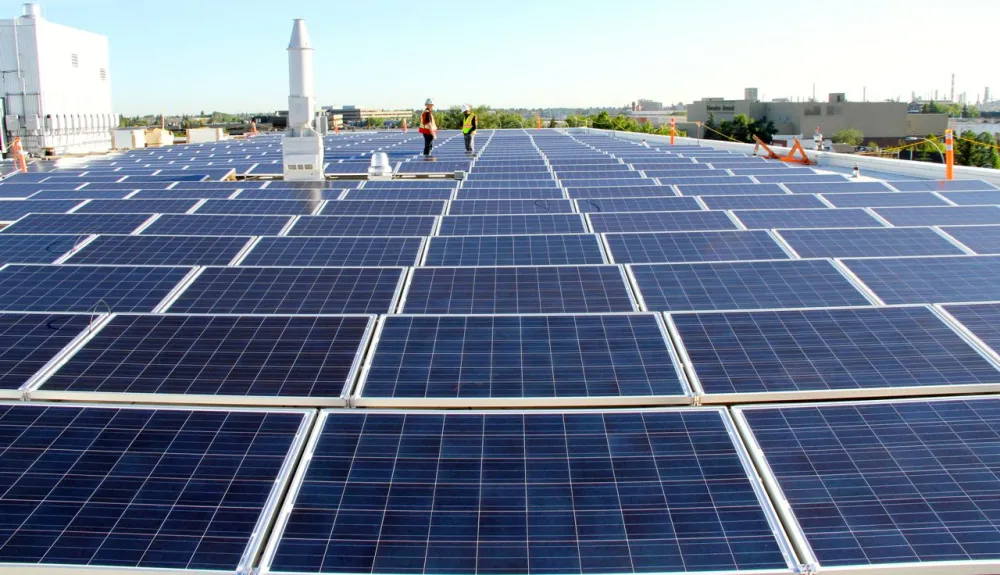On a bright fall day in early October in a packed ballroom in a downtown Calgary hotel, Frank Oberle made his first speech as energy minister to Alberta’s small solar industry.
Solar energy makes up only 5 megawatts or 0.03 per cent of Alberta’s 14,000 megawatts of electrical generation capacity but one of Alberta’s most powerful people was there, half-apologizing for his rookie status and talking about how he’s got a lot to learn.

So why was he there? It could have something to do with his boss, Premier Jim Prentice telling the Globe and Mail “We can achieve very significant emissions reductions just by not burning coal” and “I think what we should be doing is making investments in those (wind and solar) areas in the context of an overall climate plan for the province.”
Oberle's speech continued on in the same vein.
“[Solar] will be part of our mix going forward, no question… Renewables will play a part in our electricity system going forward,” said Oberle in an interview after his speech.
So that might be why CanSIA’s Solar West event was crawling with Ontario developers and solar industry folks. The Alberta micro-generation regulation aside Alberta has not provided the most supportive environment for solar energy. But Alberta has the best solar resource in Canada, a deregulated electricity market, looming coal plant retirements and growing demand for electricity.
Kickstarting Alberta’s solar industry
While Ontario solar companies are watching, it’s existing players who may be best positioned to kickstart Alberta’s nascent solar industry.
“Over the next few years I think you’re going to see more and more large-scale systems come on board. I would not be surprised to see that total installed solar capacity number double by next year. There are a lot of large projects in the mix, commercial and industrial projects that are moving forward that will help us achieve that,” says David Vonesch, an engineering partner with Skyfire Energy.
Vonesch also confirmed that Skyfire, a solar engineering, procurement and construction company based out of Calgary, will start building two megawatts worth of solar projects in Alberta later this month. When these are commissioned early next year, Alberta’s solar capacity will instantly increase by 40 per cent.
These new projects are being developed within the current rules and without any incentives. The economics make sense right now for large users of electricity who plan on staying put. From them, solar is going to be the cheapest source of electricity.
 Alberta’s current micro-gen regulation requires low cost or free interconnection for small projects, but it hasn’t been enough for the industry to really take off. That’s where a renewable energy framework comes in. Minister Oberle says such a framework is under development and that it’s “part of a larger framework on Alberta’s climate change position.”
Alberta’s current micro-gen regulation requires low cost or free interconnection for small projects, but it hasn’t been enough for the industry to really take off. That’s where a renewable energy framework comes in. Minister Oberle says such a framework is under development and that it’s “part of a larger framework on Alberta’s climate change position.”
If that renewable energy framework gets it right and properly recognizes the economic value of solar we could start to see large utility-scale projects of 10 megawatts and up.
And Alberta has utility-scale projects ready to go. A 15-megawatt project in southern Alberta is approved and waiting for financing. However, banks are loath to lend money to businesses they don’t understand, and long-term power purchase agreements are hard to come by.
But it will come. The banks or the developers will figure out how to finance these projects and the cost of solar is only going down. The International Energy Agency agrees, claiming that solar could become the largest source of worldwide electricity by 2050.
Alberta’s market access problem
Alberta is almost single-handedly going to be responsible for nearly all of Canada’s growth of greenhouse gas emissions between 2005 and 2020. Dollar for dollar, renewable energy projects have the greatest potential to reduce emissions and enhance Alberta’s flagging reputation at the same time.
Alberta burns more coal than the rest of Canada combined and it has the carbon emissions to prove it. Premier Prentice is talking about the right things in reducing coal and beefing up renewable energy.
John Gorman is the president of the Canadian Solar Industries Association and he sees solar as an opportunity for the Alberta government to address its dirty electricity problem and an immediate win as far as GHG reductions go. And it’s worth noting that the single biggest greenhouse gas reducing project the Alberta government has funded through its carbon levy program was the 300 megawatt Blackspring Ridge wind project.
Will Alberta become the next great solar electricity market in North America? Not right away, but things are looking up for this province’s plucky solar industry.










